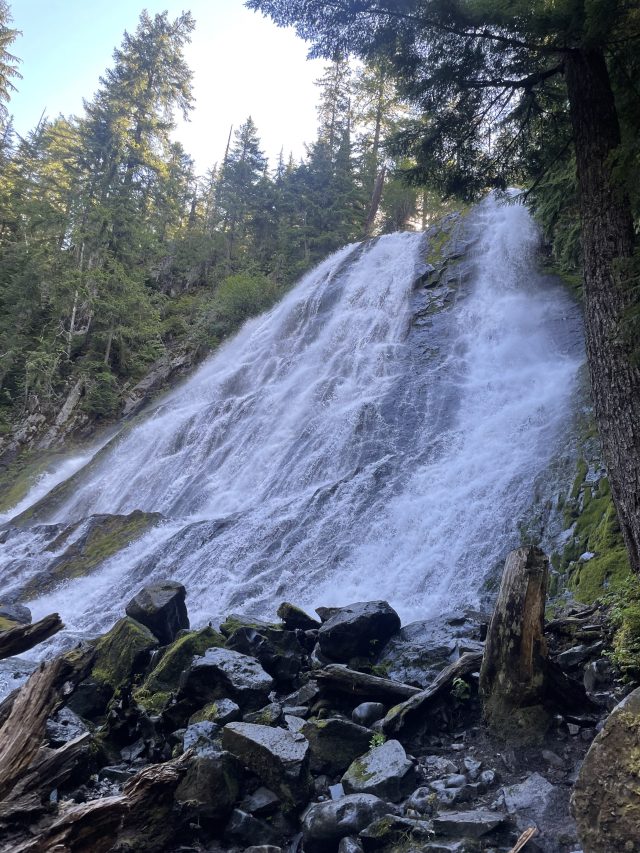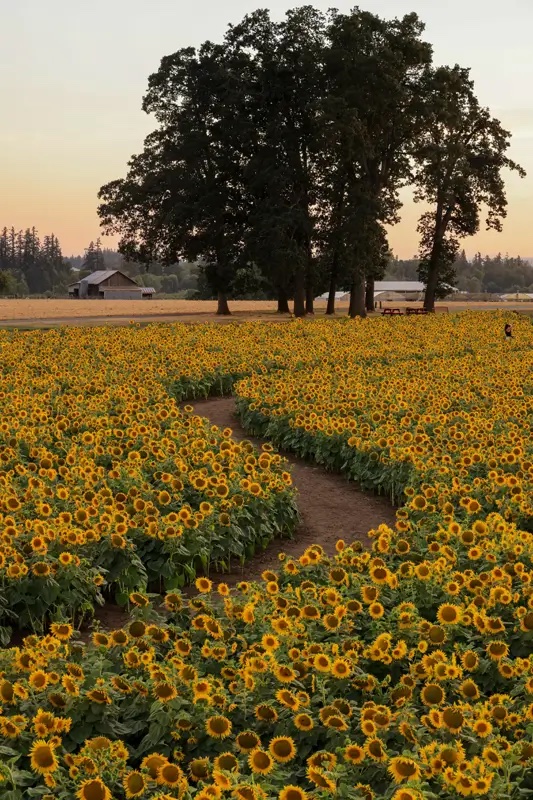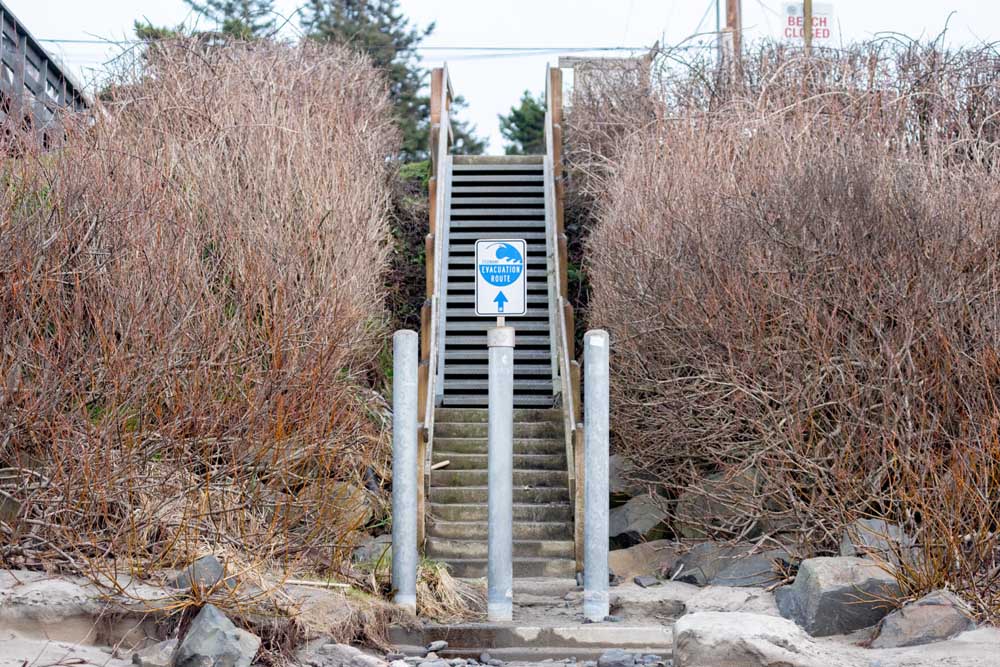Dredging up history at Sumpter state heritage site
Published 3:30 am Wednesday, July 30, 2025

- The Sumpter Valley Gold Dredge sits in a restored, shallow pond that gives visitors an idea of what it would have looked like when it was still in operation. (Makenzie Whittle)
I am always thrilled when I take a trip to northeastern Oregon.
The way the land changes several times along the lonely stretch of U.S. Highway 26 is remarkable. From the dry plateaus to the verdant forests, dramatic hills and cliffsides, pastoral farmland, the towering Strawberry Mountains, until climbing up more forested mountains as you make your way farther eastward. The long drive out is certainly worth the gas in terms of the views.
This scenic whiplash through the heart of Central and Eastern Oregon is also home to complex historical sites, both geological and cultural, as people flocked to this corner of the state with the hopes of striking it rich. One of the places mined, sluiced and dug for the yellow stuff is the tiny town of Sumpter.
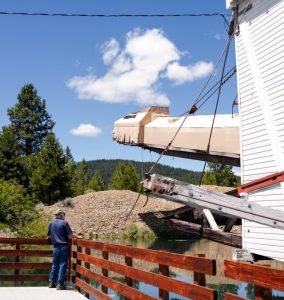
Mike Whittle looks up at the covered conveyor line on the Sumpter Valley Gold Dredge. (Makenzie Whittle)
Trending
My dad, Mike, and I headed there recently, having visited several times over the past couple of decades for the famous flea markets, and for one memorable school trip where our truck broke down. In the years we’ve found ourselves in this part of the state, it has never disappointed in terms of quiet beauty and interesting history.
Gold fever
Nestled in the Elkhorn Mountains of the larger Blue Mountain range, Sumpter is listed as a ghost town, or “near-ghost town,” in several places, including the Oregon Secretary of State’s official website, as an example of the mining history of the state. It may be sleepy, but with a population of 204, it is hardly ghostly.
Sitting off Oregon Route 7 toward Baker City, Sumpter and its surrounding area are brimming with history, especially where gold and railroads are concerned.
When gold was found in the 1860s by a few South Carolinians, things were slow to start, but when the narrow-gauge railroad track came through, connecting Baker City and Prairie City, it brought with it more industrialization and more miners, also hoping to stake their claims.
The town was platted in 1898, and it soon boomed to a population of around 2,000. It featured hotels, saloons, a brewery, churches, sidewalks and an opera house. It even had electric lights.
In 1917, a massive fire burned the majority of the town, and with the placer and lode mines yielding less and less output, people began to move away. But a few years earlier, gold dredges had started digging gold out of the river gravel, which was still lucrative enough to keep gold very much in the picture.

An old life preserver hangs on the walls of the Sumpter Valley Gold Dredge.
(Makenzie Whittle)
Trending
Three gold dredges tore through the valley, with the first two stopping operations by the 1920s. The last of them, Sumpter Dredge No. 3, was built in 1934 from parts of the first two dredges that had been left to decay in the water where they last dug through the gravel.
The massive, white-walled machine slowly worked its way around the Powder River, digging up tons of gravel and sorting out the flakes of gold that lay within it, leaving the rock as tailings in its wake.
It ran all day, every day (except the Fourth of July and Christmas and for a few years during World War II) from 1934 when it began operations, until 1954 when the company ceased operations, turning out 8.3 cubic yards of gravel every minute.
It is now restored and available to tour at the Sumpter Valley Dredge State Heritage Site.
The dredge, as with the two before it, was left where it stopped to deteriorate as it slowly sank into the pond it had made itself. It was eventually added to the National Register of Historic Places in 1971, and it, along with its tailings and surrounding land, was then purchased by the Oregon Parks and Recreation Department in the early ‘90s and began to be restored in 1995.
Among all three dredges, they traveled a total of 8 miles along the river, tearing up the landscape and shifting the river’s course along the way. They dug up between $10 and $12 million in gold, but for Dredge No. 3, the costs of operating the behemoth boat outpaced the minerals it extracted as the years went on and the cost of gold remaining stagnant after the war, the Powder Dredging Company that owned it in the ‘50s was $100,000 in debt when it ceased operations.
Life finds a way
Visiting the dredge today, which is open seasonally, May through October, you can get an up-close look at the massive scoops, gears and inside the lower floor.
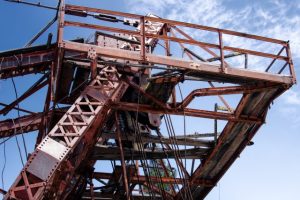
The steel bow gantry of the Sumpter Valley Gold Dredge has patina and rust from decades of weathering. (Makenzie Whittle)
The wood creaks underfoot and the smell of machinery still lingers in the air even after 71 years since it fell silent. With a few interpretive signs around the main floor, you can get a sense of the scale of operations and try to take a moment to imagine the deafening noise that workers must have experienced during their shift as the dredge slowly dug through the river gravel.
The dredge’s restoration was taken on by locals who wanted to see it preserved. The Friends of the Sumpter Valley Gold Dredge continue, along with the OPRD, to do just that through donations and grants.
The park now has several short and easy walking trails around the dredge through the tailings, where you can get a better idea of the scope of scarring these machines did to the landscape, as well as how nature is reclaiming the space with the cool, clear water flowing through the steep gravel beds and trees, bushes and rushes growing from the rocky slopes.
Through the summer, there are also chances to go on guided tours and gold panning on weekends, where you can pan for free and keep the gold you may find for a small fee.
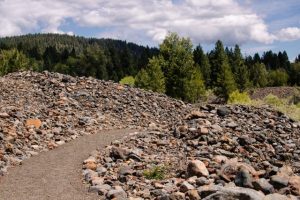
The South Trail at the Sumpter Valley Dredge State Heritage Site loops around some of the tailings left by Sumpter Dredge No. 3 and passes by the headwaters of the Powder River. (Makenzie Whittle)
Revisit
While my dad and I perused the many informational signs in the small visitor center and gift shop at the dredge, we realized that when we had visited with my class trip, it was only one year after the site had opened to the public for tours.
Revisiting over the years has allowed us to see the slow progression that has been made from restored siding, recovering the scoops and the improved boardwalk that leads into the dredge itself. But, as a sign indicates on the dredge, that “the equipment in… [the] dredge is left in its natural state,” providing a bare bones, yet substantial look into this slice of Oregon’s history.
Ride the rails
When you are visiting Sumpter, also be sure to check out the Sumpter Valley Railroad, which offers rides on select weekends and major holidays. The railroad operates on restored steam and diesel locomotives on a section of the old narrow-gauge track between Sumpter and McEwan that was rebuilt almost entirely by volunteers. Reservations fill up, so book ahead on their website.
Be sure to also stop off at the Sumpter Valley Interpretive Site along U.S. Highway 26 for a short trail to some remaining tracks of the old narrow-gauge railroad that made its way down the mountains.
If you go
Where: Sumpter Valley Gold Dredge State Heritage Area, 211 Austin St, Sumpter
When: Open daily from 7 a.m.-7 p.m. May through October
Cost: Donation
Contact: stateparks.oregon.gov or 541-894-2486
Getting there: From Prineville, travel 144 miles east on U.S. Highway 26. Turn left onto Oregon Route 7 towards Baker City and drive 25 miles until turning left again onto Oregon Route 410 towards Sumpter. Drive 3 miles into town and then turn left onto Austin Street and continue toward the dredge.
Bonus stop: The ghost town of Whitney
Along Oregon Route 7 12 miles southwest of Sumpter sits the ghost town of Whitney.
Once a stop along the old narrow-gauge Sumpter Valley Railway, the small community was a former logging town along the Burnt River.
Its history of milling lumber is, however, shorter than nearby company towns, like Bates, as the original mill burnt down in 1918 and was never fully rebuilt.
The town especially dwindled after the railroad closed in 1947, with houses and other structures left behind.
Today, a few folks have taken up residence, but there are several buildings that nature is slowly reclaiming, making the ghostly spot primed for photography.
If you do visit, be aware of private property and be courteous to those who do live here.
Each building shows the years of weather and wear on the old boards and tin roofs, and under either sunny or stormy skies, this place is worth stopping off for a look when you’re in the area.


